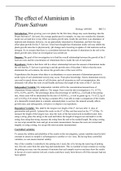Essay
Biology 3.1 Investigation
- Course
- Institution
This document is for my NCEA level 3 internal, where we must do our own biological investigation for the 3.1. Aluminium can inhibit plant growth, and so we did this for our investigation, I got one of the best in the class.
[Show more]



